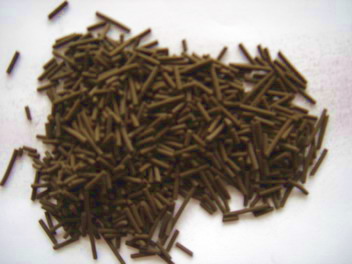
1.Product features and scope of application
Coke oven off-gas hydrogenation catalyst CC-00046 is an iron-molybdenum catalyst applicable to hydrodesulfurization of organic sulfur in coke oven off-gas containing ≤10% CO and about 5% olefins. Total organic sulfur conversion of over 99% can be attained for coke oven off-gas containing 100 to 250mg/ Nm3 organic sulfur under following condition: GHSV 500 to 1000h-1,temperature 380-450℃, pressure 1.0-2.0MPa(g).
Main reactions involved are as follows:
COS+H2 = CO+H2S
RSH+H2 = RH+H2S
R1SR2+2H2 = R1H+R2H+H2S
R1SSR2+3H2 = R1H+R2H+2H2S
C4H4S+4H2 = C4H10+H2S
2. Physical properties
Appearance | Pale-brown cylinders |
Particle size /mm | Ф6×4-6mm |
Bulk density/kg·L-1 | 0.9-1.2 kg/L |
3. Quality Standard
Side crushing strength(average) | min150 N |
Loss on Attrition | max5% |
Activity test: there is still no industry standard for the catalyst. Activity of the catalyst is tested according to the standard of similar organic sulfur hydrogenation catalyst on a impulse- micro- reactor- chromatography testing apparatus at atmospheric pressure and 380℃. Thiophene conversion should be above 70%.
4. Operation condition
Feed:coke oven off-gas containing 100-250mg/Nm3 organic sulfur, 10%CO and about 5% olefins.
Pressure | atmospheric to 2.0 MPa |
Temperature | 380-420℃ |
GHSV | 500-1000 h-1 |
H2S in feed gas | >100ppm |
NH3 in feed gas | ≤100 ppm |
5. Storage, transportation and loading
Storage and transportation:
(1) The catalyst is packed in air-tight iron barrel lined inside with plastic bags. It should be stored in dry and well-ventilated place.
(2) Avoid tumbling and collision during transportation to prevent breakage of the catalyst
Loading:
(1) The catalyst is loaded in three sections in the reactor. φ10mm inert balls are installed both at the top and bottom and among the sections. The catalyst and inert balls are separated by stainless wire net of smaller mesh size than the catalyst.
(2) Clean the reactor of any debris and inspect soundness of facilities and valves connected to the reactor.
(3) Determine depth of each section according to total amount of the catalyst. Install inert balls and stainless wire net at the bottom . The net should be tightly overlapped around the margin to avoid leakage of the catalyst.
(4) Screen out any dust in the catalyst before loading. Drop the catalyst slowly from a small barrel at lowest possible height ( less than 1 m) into the reactor and disperse the particles uniformly in the bed to ensure well-distributed gas flow during operation.
(5) In-situ loading operator should stand upon wooden plate without standing directly upon the catalyst.
(6) Level off top surface of the bed at the end of loading. Withdraw all the tools from the reactor and close all the manholes to prevent moisture invasion.
(7) The loading operators should be properly equipped with necessary protective means.
6. Start-up, warming-up and presulfiding
Presulfiding of the catalyst is necessary because unsulfided catalyst has low and unstable activity to organic sulfur hydrogenation but considerable activity to CO methanation. The presulfiding reactions are as follows:
Fe2O3+2H2S+H2=2FeS+3H2O
MoO3+2H2S+H2=MoS2+3H2O
Nitrogen, hydrogen-nitrogen, poor gas or coke oven off-gas can be employed as the preheating medium, each with different procedure as follows.
(1) Hydrogen-nitrogen
Warming-up: ambient to 120℃ at 20-30℃/h; 120℃ for 4h; 120 to 200℃ at 20-30℃/h; 200℃ for 2h; 200 to 360℃ at 20-30℃/h.
Sulfiding: Add CS2 into hydrogen-nitrogen. Control sulfur concentration at 0.5-1.0%(vol) and GHSV at 300-500h-1 and perform sulfiding at constant temperature until CS2 equivalent to theoretical sulfur absorption capacity is added. Then shift from half- to full-load normal operation.
(2) Coke oven off-gas
For plant without hydrogen-nitrogen supply, coke oven off-gas or water gas of high sulfur content can be employed as warming-up and sulfiding medium (for those of low sulfur content, supplement CS2 when temperature reaches 200℃).
Warming-up and sulfiding: warm up at 20-30℃/h. Maintain at 120℃ for 8h; 200℃ for 2h; 400℃ for 10h. GHSV 500-700h-1,sulfur concentration in the gas 0.5-1.0%.
To speed up the sulfiding, raise the operation temperature from atmospheric to 1.0MPa.
7. Shutdown
Temporary shutdown:
Close inlet and outlet valves and maintain at positive pressure and the temperature.
Long-term shutdown:
Cool down the bed temperature at 30℃/h to ambient with feed gas. Close inlet and outlet valves and maintain at positive pressure with nitrogen
When reactor disassembly for maintenance or catalyst changeover is needed, passivate the catalyst with steam-air or nitrogen-air and then cool down the bed at 30℃/h to ambient temperature with air before disassembly.
8. Regeneration
Activity of the catalyst may deteriorate with service time due to coke formation. When this deterioration becomes intolerable to operation requirement, it is necessary to regenerate the catalyst.
The catalyst is usually regenerated by controlled combustion. Employ inert gas or steam as the medium and incorporating air progressively from 0.1-1.0% oxygen concentration to finally totally air, in such a controlled way that bed temperature rise is less than 30℃/h. Perform the regeneration until no temperature rise is observed and oxygen in inlet and outlet stream approaches the same. Then maintain at 450℃ for 6h and finish the regeneration. Then cool down the bed at 30℃/h to starting temperature for presulfiding, switch to purging with nitrogen or other inert gases, do pre-sulfiding and finally shift to normal operation.
Closely inspect temperature rise and strictly control air incorporation
during the regeneration to prevent temperature surge which may cause loss of activity of the catalyst.
Please leave a message for us or use the following ways to contact us, we will reply to you as soon as possible, and provide you with the most sincere service, thank you.